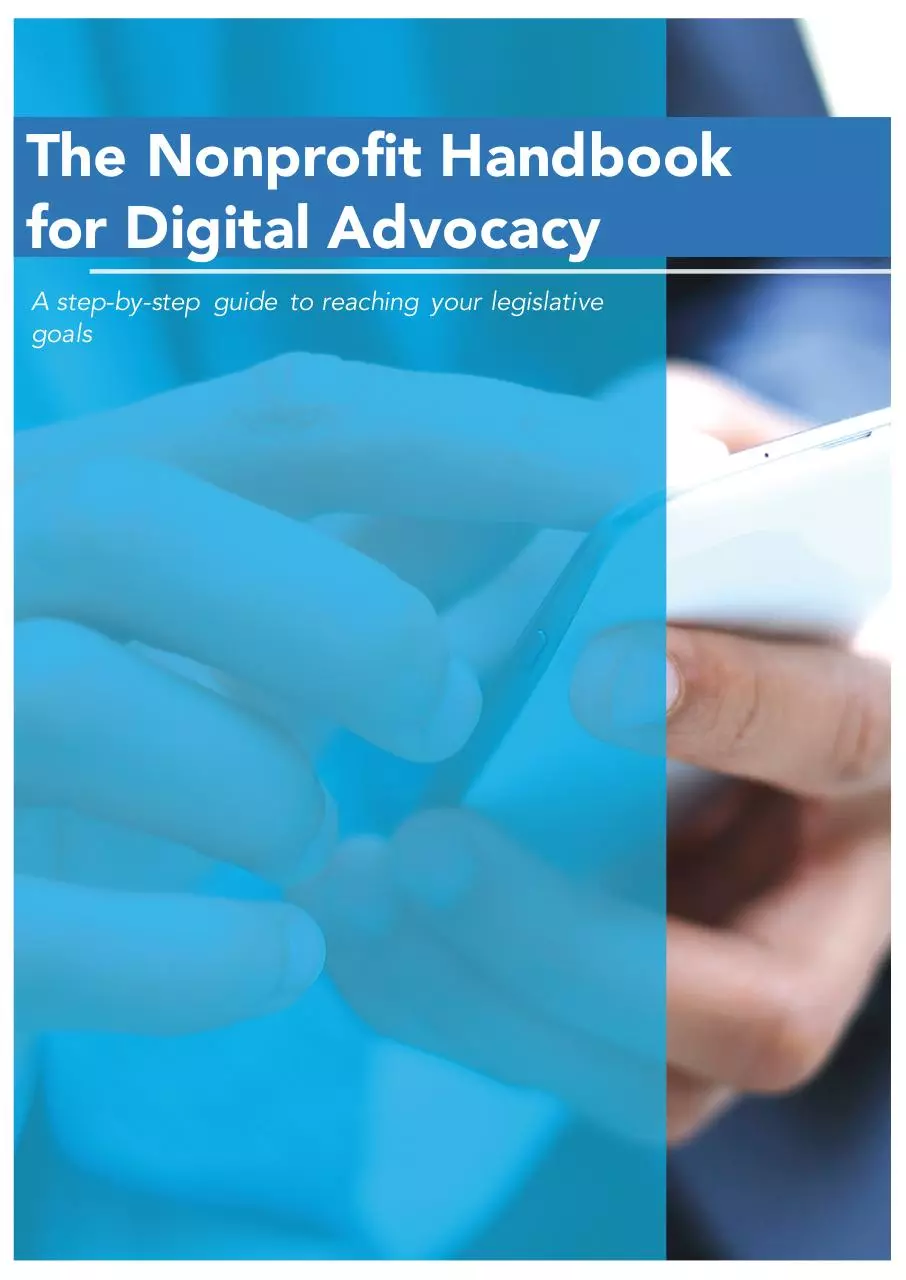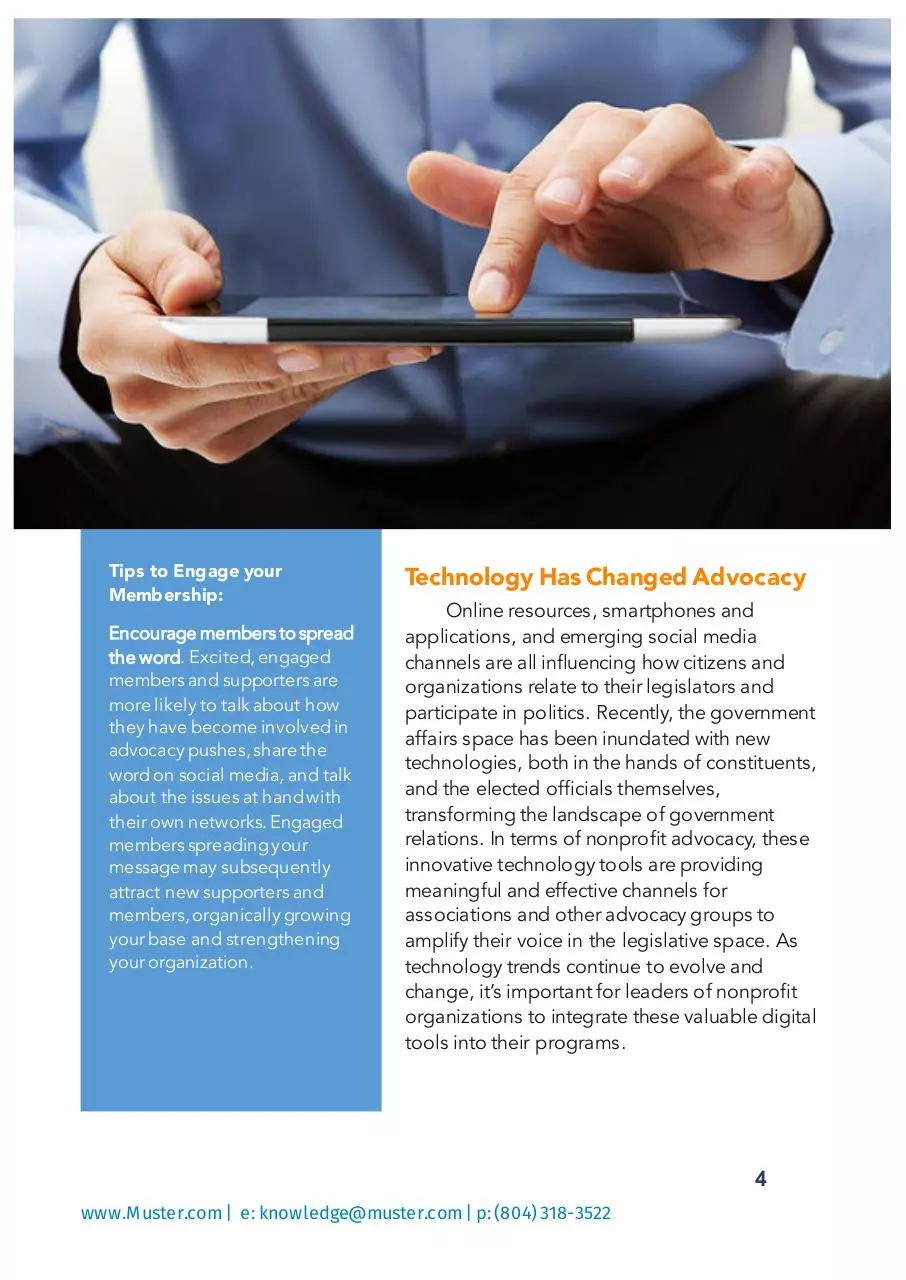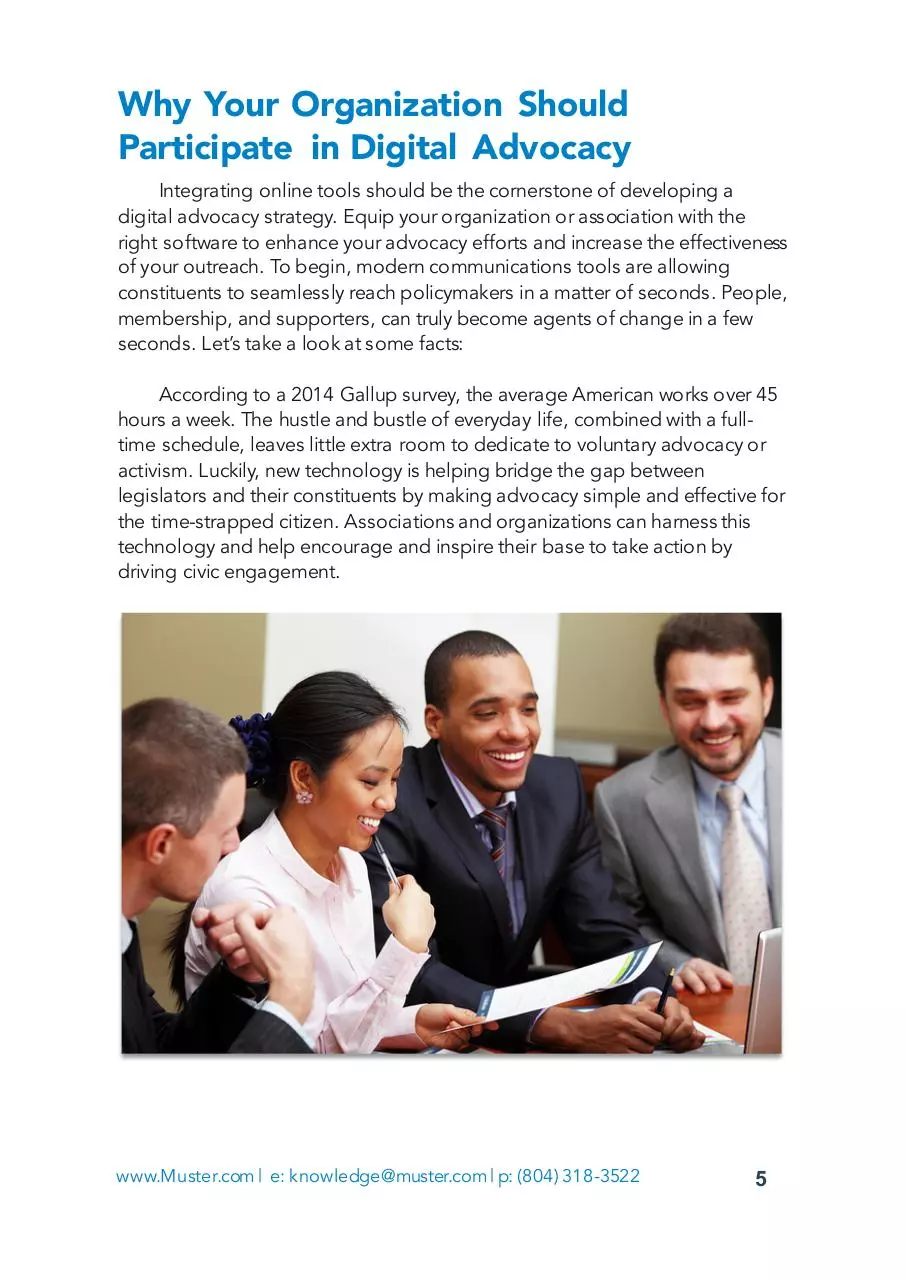The Nonprofit handbook for digital advocacy (1) (PDF)
File information
Title: The Nonprofit handbook for digital advocacy (1)
This PDF 1.3 document has been generated by PowerPoint / Mac OS X 10.10.3 Quartz PDFContext, and has been sent on pdf-archive.com on 23/11/2015 at 21:09, from IP address 50.242.x.x.
The current document download page has been viewed 559 times.
File size: 10.87 MB (12 pages).
Privacy: public file





File preview
The Nonprofit Handbook
for Digital Advocacy
A step-by-step guide to reaching your legislative
goals
Contents
Technology Has Changed Advocacy
3
4
Why your Organization Should Participate in Digital Advocacy
5
The Pros of Digital
6
Step One: Create an Advocacy Statement
7
Step Two: Engage Membership for Stronger Activity
8
Step Three: Use the Legislative Tool As a Tool for Engagement
9
10
The Nonprofit Advocacy Landscape
Step Four: Let Constituents Know They are Appreciated
A Note About Analytics
Conclusion
www.Muster.com | e: knowledge@muster.com | p: (804) 318-3522
11
12
The Nonprofit Advocacy Landscape
Organizations and associations serve the
public good and fulfill many civic purposes.
Often, these groups exist for issue advocacy
and/or the goal of advancing a focused mission
within an industry. Citizens join and support
these nonprofits, frequently paying annual dues,
to be a member of a community of like-minded
individuals. Often, policy advocacy comes handin-hand with an association’s strategic plan, and
"The secret to change is
can be leveraged as a public relations and
to focus all of your energy,
operations tool. Our handbook discusses
not on fighting the old,
political advocacy in relation to member
engagement, and provides helpful tips to
but on building the new.”
achieve and maintain a successful digital
-Socrates
advocacy plan.
Digital advocacy may form a nonprofit’s government relations plan in totality or serve
as a part of a wider strategy. As technology continues to become democratized and
disrupt traditional lobbying, the digital realm of advocacy is crucial to creating
awareness and informing stakeholders, motivating action and influencing decisionmakers.
3
www.Muster.com | e: knowledge@muster.com | p: (804) 318-3522
3
Tips to Engage your
Membership:
Encourage members to spread
the word. Excited, engaged
members and supporters are
more likely to talk about how
they have become involved in
advocacy pushes, share the
word on social media, and talk
about the issues at hand with
their own networks. Engaged
members spreading your
message may subsequently
attract new supporters and
members, organically growing
your base and strengthening
your organization.
Technology Has Changed Advocacy
Online resources, smartphones and
applications, and emerging social media
channels are all influencing how citizens and
organizations relate to their legislators and
participate in politics. Recently, the government
affairs space has been inundated with new
technologies, both in the hands of constituents,
and the elected officials themselves,
transforming the landscape of government
relations. In terms of nonprofit advocacy, these
innovative technology tools are providing
meaningful and effective channels for
associations and other advocacy groups to
amplify their voice in the legislative space. As
technology trends continue to evolve and
change, it’s important for leaders of nonprofit
organizations to integrate these valuable digital
tools into their programs.
4
www.Muster.com | e: knowledge@muster.com | p: (804) 318-3522
Why Your Organization Should
Participate in Digital Advocacy
Integrating online tools should be the cornerstone of developing a
digital advocacy strategy. Equip your organization or association with the
right software to enhance your advocacy efforts and increase the effectiveness
of your outreach. To begin, modern communications tools are allowing
constituents to seamlessly reach policymakers in a matter of seconds. People,
membership, and supporters, can truly become agents of change in a few
seconds. Let’s take a look at some facts:
According to a 2014 Gallup survey, the average American works over 45
hours a week. The hustle and bustle of everyday life, combined with a fulltime schedule, leaves little extra room to dedicate to voluntary advocacy or
activism. Luckily, new technology is helping bridge the gap between
legislators and their constituents by making advocacy simple and effective for
the time-strapped citizen. Associations and organizations can harness this
technology and help encourage and inspire their base to take action by
driving civic engagement.
www.Muster.com | e: knowledge@muster.com | p: (804) 318-3522
5
The Pros of Digital
Digital advocacy tools are also
valuable to grow membership and
supporter lists, easily and without any
extra legwork. Utilizing a software
solution to organize and manage
contacts removes the hassle of
organizing names and addresses on
various spreadsheets. Do you know
anyone who manually
updates their membership lists on
Excel or antiquated spreadsheets?
Advocacy software platforms allow an organization to easily cultivate and
maintain up-to-date records for all members in one platform. Digital advocacy
platforms simplify the process to empower supporters in becoming advocates
for an organization’s cause. These online platforms allow organizations to easily
engage their members through social media, networking sites, and emails.
How many times have you run across a website’s “Take Action” center only to
find a huge block of text describing the steps you need to take to participate?
Digital Calls to Action make advocacy easy for both the organization and for
supporters.
People often say that, in a democracy, decisions are
made by a majority of the people. Of course, that is not
true. Decisions are made by a majority of those who
make themselves heard…
- Rep. Walter H. Judd
www.Muster.com | e: knowledge@muster.com | p: (804) 318-3522
6
Step One
Create an Advocacy Statement
The first step in implementing any type of digital advocacy strategy or
software system is to create an advocacy mission statement. This policydriven statement must align with the organization’s long-term strategic
goals and supplement the group’s current activities.
Advocacy can be presented as a form of strategic public relations- building the
association’s brand and driving awareness about its mission. Unlike many non-profit
501(c)3 organizations and charity organizations, professional associations and other
501(c)6 groups frequently struggle with crafting a compelling advocacy message
that extends beyond the reach of their membership- and that is okay.
The power of association
advocacy lies in the unified voice
of the membership, not always
from grassroots support. Even if
governmental advocacy is not an
explicit component of the
association’s daily agenda,
reminding members of the
association’s general policy
mission is important on a
year-round basis. This can be as simple as providing a small text box in the
association’s monthly newsletter, adding a bullet point somewhere on the
association’s website and occasionally posting to social media. The desired
legislative results should be reflective of your mission statement, so make it clear
and concise. Action Alerts should also clearly articulate the ultimate goals of certain
policy change.
www.Muster.com | e: knowledge@muster.com | p: (804) 318-3522
7
Step Two
Engage Membership for
Stronger Advocacy
Engagement is more than
communication. Engagement
inspires, encourages and mobilizes.
Without the active support of the
membership, advocacy loses its
citizen-driven power. An association
that successfully implements and
executes a membership-oriented
advocacy strategy will have a
stronger and more powerful
connection with its members.
Engagement benefits everyone
involved: a thriving association and
a satisfied member who feels a
sense of belonging with a
meaningful connection to the
association. Members who care
about an issue and believe in the
mission of your organization will be
more than happy to advocate when
legislative action is needed.
Tips to Engage your
Membership:
Communicate often, but not too
often. Take advantage of all that
social media has to offer and
communicate with your
membership/supporters as
frequently as you can through
your various accounts. However,
when it comes to e-newsletters
and emails, think strategically
about releasing communications.
Be aware that frequent
communications may cause some
members to unsubscribe.
Consider integrating offline and
online membership
correspondence for a more
complete communication
approach.
Engaging your membership will pay big dividends when it come to
future advocacy campaigns. The Congressional Management Foundation
found that: “Internet users who contacted Congress were motivated to
do so because they cared deeply about an issue (91%). Even a majority
(88%) of those who contacted Congress as a result of a third party
request indicated this was part of their reason for doing so.”1
1. http://www.congressfoundation.org/component/content/article/253
www.Muster.com | e: knowledge@muster.com | p: (804) 318-3522
8
Step Three
Use Legislative Results as a Tool
for Engagement
Create a legislative timeline. Know when your
state’s legislative session is occurring, and map out
key pieces of legislation you are hoping to
influence. Strategically engage your contacts in
light of upcoming legislative moves. During the
legislative session, keeping track of the
membership’s involvement in advocacy is crucial.
Anytime that a bill is passed or killed in favor of
“Political mobilization is
your association’s policy stance, immediately let
seldom spontaneous”
your members know that their role in contacting
-Jack Walker
their legislators was part of real change.
Members need to know that they are valuable and their contributions led to a
certain result, and in doing so, engagement will skyrocket. (Sidebar: at Muster,
we’ve seen engagement rates so high, nearly every single member contacted
their elected official and the association was successful in passing it’s bill!).
Tips to Engage your Membership:
Create a sense of community
Think about the common bond between
your membership and/or supporter base.
Are they all working in the same profession?
Do they all live in the same state? Find
connections between those who support
your organization, and use those
connections to create a sense of solidarity
among your members and supporters.
Strengthening your relationship with your supporters goes beyond the
direct association-contact connection. It’s helpful to create a sense of
community among your members by helping them feel unified (think: “we”
are in this together!). When the legislative sessions roll around, your
membership will feel like they are acting as a part of a greater unit, acting
on behalf of an issue that affects their own community.
www.Muster.com | e: knowledge@muster.com | p: (804) 318-3522
9
Download The Nonprofit handbook for digital advocacy (1)
The Nonprofit handbook for digital advocacy (1).pdf (PDF, 10.87 MB)
Download PDF
Share this file on social networks
Link to this page
Permanent link
Use the permanent link to the download page to share your document on Facebook, Twitter, LinkedIn, or directly with a contact by e-Mail, Messenger, Whatsapp, Line..
Short link
Use the short link to share your document on Twitter or by text message (SMS)
HTML Code
Copy the following HTML code to share your document on a Website or Blog
QR Code to this page

This file has been shared publicly by a user of PDF Archive.
Document ID: 0000316939.